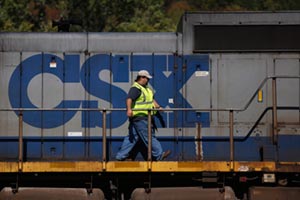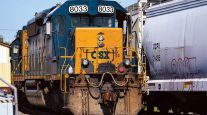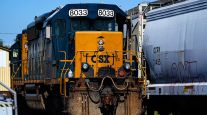CSX Profit Meets Estimates as Crude-by-Rail Fallout Looms

CSX Corp. matched analysts’ profit estimates as the U.S. economic recovery boosted demand for consumer goods moved by rail while crude shipments kept growing amid the global rout in prices.
The fourth-quarter results, the first by a U.S. railroad, gave a broad glimpse into the benefits from lower energy costs before producers began paring investment in the oil patch. U.S. railroads, a gauge of economic health because of the range of products they haul, saw traffic rise 4.5 % in the period.
“The positive economic tailwinds are certainly helping the volumes,” said Allison Landry, a New York-based analyst with Credit Suisse Group AG, in a telephone interview before Tuesday’s earnings release. “In general, there’s fairly broad-based strength across the commodity types.”
CSX, the largest railroad in the eastern U.S., reported quarterly net income rose to $491 million, or 49 cents a share, from $426 million, or 42 cents, a year earlier. That met the 49-cent estimate of 26 analysts surveyed by Bloomberg.
Sales rose 5.3% to $3.19 billion, Jacksonville, Florida-based CSX said. Analysts had predicted $3.18 billion.
“CSX is capturing broad-based market strength,” Chief Executive Officer Michael J. Ward said in the statement. “We expect to continue growing our intermodal and merchandise businesses faster than the economy, pricing above inflation and driving efficient asset utilization.”
The report set the stage for earnings releases next week by Union Pacific Corp., the biggest publicly traded U.S. railroad; Canadian Pacific Railway Ltd. and Kansas City Southern. Norfolk Southern Corp. and Canadian National Railway Co. will announce their results the following week.
Consumer spending, buoyed by more jobs and cheap gasoline, has expanded 4% or more from a year earlier for the past eight months, the longest stretch since 2011. That drove a 4.5% increase for rail intermodal shipments, containers of general merchandise that can be hauled by ship, truck and train and that accounts for more than 40% of U.S. carloads.
Carload growth in the quarter was led by a 15% gain for chemicals, driven by crude and fracking-sand shipments. Coal rose 11% while grain dropped 2.7%. CSX’s intermodal carloads increased 5%.
Even though crude-by-rail has grabbed attention as West Texas Intermediate oil has sunk below $50 a barrel from more than $100 in July, those shipments make up only about 2% of CSX’s volumes. Falling crude prices that would damp tank-car traffic also leave more money in consumers’ pockets, said Lee Klaskow, a senior logistics analyst with Bloomberg Intelligence.
“Lower oil equates to lower gasoline prices, and that means people will be spending more,” he said. “It’s likely to be offset by other freight that the rails haul,” such as autos or containers of consumer goods.
Gains in other freight categories, including crude, have helped CSX and the rest of the rail industry weather the slump in coal shipments as utilities switch to cheaper natural gas. Coal accounted for 23% of CSX’s fourth-quarter revenue, down from 31 % three years earlier.
CSX’s total expenses rose by $503 million last year as the railroad hired more workers and added equipment to improve service. That pushed up the operating ratio, in which a lower number shows increased efficiency, to 71.5% from 71.1% in 2013.
An eventual respite in crude-by-rail demand may help CSX and other railroads improve service, which deteriorated amid a harsh winter in 2014 coupled with an unexpected surge in grain and oil shipments. CSX’s average train speed fell to 20.4 miles (32.8 kilometers) per hour in the quarter, from 22.9 mph a year earlier.
“It’s pretty good for the railroads,” John Larkin, a Dallas-based analyst at Stifel Financial Corp., said by e-mail. “In a perfect world, their service would be better, they would have fewer capacity restraints and the coal business would not have downsized so dramatically.




